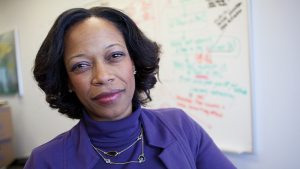 Ben Sheredos and Rebecca Hardesty gave us a real treat last night.
Ben Sheredos and Rebecca Hardesty gave us a real treat last night.
In a brilliant double act, which one audience member aptly described as ‘thrilling,’ they presented a subtle, self-reflexive consideration of the problem of interdisciplinarity in Science Studies.
He is a recent graduate of UCSD’s program in philosophy and cognitive science currently doing a postdoc with a group of biologists studying circadian rhythms. She is a PhD candidate in our Communication Department, with a background in formal epistemology, currently embedded in a neuroscience lab.
Ben kicked off the proceedings with a ‘talk within a talk,’ outlining the lengthy discussion and review process by which circadian rhythm scientists decide how to represent biological clocks in their diagrams. He then turned the analytical lens on himself, describing the exasperating peer review process he is currently suffering through as he tries to get a paper on the diagrams published in a history and philosophy of science journal.
Rebecca’s presentation followed a similar structure. First she narrated the ironic tale of how her scientists have developed a mouse model of Down’s Syndrome that they insist is the ‘gold standard’ for studying the condition. In defiance of this verdict, however, they do not use it in their own research because it is expensive, aggressive, short-lived, non-procreative, and doesn’t mimic the cognitive impairments found in humans. Pulling the camera back, she then mused on why the various audiences for her talks refuse to recognize her work as truly interdisciplinary between philosophy and science studies.
The whole thing was as satisfying and ingenious as a Chinese Box, with drawers full of treasures and hidden compartments springing open at a touch.
In the Q&A, Lilly Irani sketched all the different players and constituencies that Ben and Rebecca had mentioned, and asked whether ‘interdisciplinary’ was really the right term. ‘What do you actually do when you’re with the scientists?’ she asked Rebecca. The answer was totally unexpected. Rebecca is one of the few native English speakers in the lab, and, in her capacity as a ‘comm person’ she serves as sort of translator. She will tell the Anglophone scientists what one of their English-as-a-second-language colleagues said, sometimes having to use phonetic approximations for unfamiliar technical terms, which in turn get translated into scientific English. ‘Worthy of another whole book,’ Lilly opined.
Rebecca’s answer to Lilly’s question lay so far outside any notion of ‘communicating across fields’ that it made a nonsense of the whole arid concept. It was so jarringly human that it had the effect of replacing the notion of interdisciplinarity with something warm-blooded and alive, something about aligning with one another’s needs and interests, making ourselves useful, and promoting dialog at all levels and registers.
Complex, candid, and subtle, this colloquium session was a true lesson in communication.

